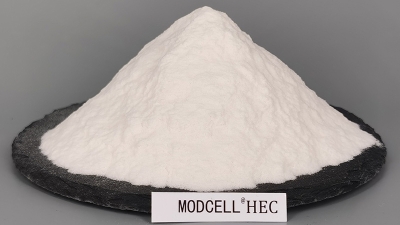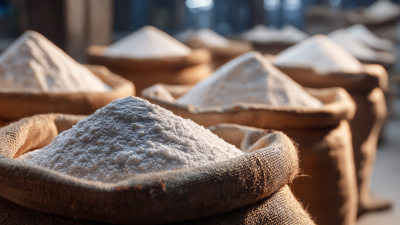7 Essential Tips for Understanding Hydroxyethyl Cellulose Solubility in Water
Table of Contents
- Understanding Hydroxyethyl Cellulose: A Deep Dive into Its Water Solubility
- Factors Influencing Hydroxyethyl Cellulose Solubility in Various pH Levels
- Temperature Dynamics: How Heat Affects Hydroxyethyl Cellulose Dissolution
- Comparative Analysis of Hydroxyethyl Cellulose Solubility Across Different Molecular Weights
- The Role of Ionic Strength in Hydroxyethyl Cellulose Water Solubility Enhancement
- Practical Applications: Utilizing Hydroxyethyl Cellulose's Unique Solubility Properties in Formulations
- Exploring the Benefits of HEC ZS81 Hydroxyethyl Cellulose in Enhancing Water-Based Paint Formulations
- FAQS
- Conclusion
- Related Posts
 Getting a good grip on how Hydroxyethyl Cellulose (or HEC) dissolves in water is pretty important for folks in the construction world—whether you're a manufacturer or a contractor. This stuff isn’t just some random chemical; it’s a real game-changer as a thickener and stabilizer across lots of different building projects. If you’ve been keeping an eye on the market, you'll see that, according to a recent report from MarketsandMarkets, the global market for construction chemicals is expected to hit around $450 billion by 2025. That’s mainly because there's a big push for more sustainable building solutions these days. HEC plays a huge role here, helping improve the workability and durability of construction materials—making everything stronger and easier to work with. At Longou International Business (Shanghai) Co., Ltd., we’re all about finding innovative ways to use HEC effectively. We know how tricky its water solubility can be, and understanding what influences that is key to developing high-quality materials that meet the tough standards of the construction industry. Basically, knowing your stuff about HEC’s solubility isn’t just a geeky detail—it’s crucial for building better, more reliable things.
Getting a good grip on how Hydroxyethyl Cellulose (or HEC) dissolves in water is pretty important for folks in the construction world—whether you're a manufacturer or a contractor. This stuff isn’t just some random chemical; it’s a real game-changer as a thickener and stabilizer across lots of different building projects. If you’ve been keeping an eye on the market, you'll see that, according to a recent report from MarketsandMarkets, the global market for construction chemicals is expected to hit around $450 billion by 2025. That’s mainly because there's a big push for more sustainable building solutions these days. HEC plays a huge role here, helping improve the workability and durability of construction materials—making everything stronger and easier to work with. At Longou International Business (Shanghai) Co., Ltd., we’re all about finding innovative ways to use HEC effectively. We know how tricky its water solubility can be, and understanding what influences that is key to developing high-quality materials that meet the tough standards of the construction industry. Basically, knowing your stuff about HEC’s solubility isn’t just a geeky detail—it’s crucial for building better, more reliable things.
Understanding Hydroxyethyl Cellulose: A Deep Dive into Its Water Solubility
Hydroxyethyl cellulose (HEC) might sound like a mouthful, but it's actually a pretty amazing non-ionic cellulose ether that’s used all over the place — from cosmetics to medicines — mainly because it dissolves so well in water. Knowing how well HEC dissolves is a big deal, since it affects how it performs in different formulations. Things like its molecular weight and how much it’s been modified (the degree of substitution) really impact how it interacts with water molecules.

When you add HEC to water, its structure helps form hydrogen bonds between the polymer chains and water molecules. This is a key part of how it dissolves—allowing it to swell up and spread evenly throughout the liquid.
But, a bunch of factors can influence this process—like temperature, pH levels, or even the presence of salts. For example, warming things up tends to make HEC dissolve more easily, while a lot of salt can actually slow it down. For folks working on designing products, understanding these little details can make all the difference, helping them tweak things to get just the right thickness, stability, and overall performance.
Factors Influencing Hydroxyethyl Cellulose Solubility in Various pH Levels
You know, hydroxyethyl cellulose (HEC) plays a pretty important role when it comes to construction materials. It’s especially interesting because how well it dissolves in water depends a lot on the pH level. For companies like Longou International Business (Shanghai) Co., Ltd., understanding how HEC behaves in different pH environments is really key — it directly affects how well their construction chemicals perform. From what I’ve read, HEC’s solubility can change quite a bit depending on the pH of the solution. For example, it tends to dissolve better in neutral to slightly alkaline solutions, say around pH 7 to 9, where it can dissolve up to 25% in certain mixes. That’s pretty useful, especially for cement-based products, where you need a consistent texture and viscosity, you know?
But it’s not just pH — temperature, ionic strength, and even other chemicals present can really influence how HEC dissolves. Like, if the temperature goes above 60°C, its solubility in acidic conditions (pH less than 7) can drop, which might cause some issues when you're trying to keep the application consistent. Industry reports suggest that keeping conditions just right can really boost HEC’s performance — which is super important for big construction projects worldwide. Here at Longou, we’re always working on optimizing these factors to give our customers the best solutions possible, even amidst all the complex stuff that comes with construction materials.
Temperature Dynamics: How Heat Affects Hydroxyethyl Cellulose Dissolution
You know, temperature really has a big impact when it comes to dissolving Hydroxyethyl Cellulose (HEC) in water. It’s a temperature-sensitive polymer, so as things get warmer, HEC tends to dissolve more easily. When you heat it up, the molecular chains start moving around more—gaining energy and interacting better with water molecules. That makes the whole dissolving process way smoother. For industries like cosmetics, pharmaceuticals, and food, understanding this is super important because they need to control viscosity precisely in their formulations.

Plus, it’s not just about how well HEC dissolves—temperature also influences its viscosity. When the solution gets hotter, it usually becomes less viscous, which makes it easier to mix into different products. On the flip side, cooling things down can make the solution thicker, so sometimes you’ve gotta adjust your application techniques a bit. Essentially, keeping an eye on temperature isn’t just about stuff dissolving; it’s also about hitting that perfect texture and performance in the final product. If manufacturers monitor and control the environment well, they can make sure their Hydroxyethyl Cellulose works just right and maintains good quality throughout the process.
Comparative Analysis of Hydroxyethyl Cellulose Solubility Across Different Molecular Weights
Hydroxyethyl cellulose (HEC) has some pretty interesting behavior when it comes to dissolving, and a lot of it depends on its molecular weight. Recent research shows that the lower molecular weight versions tend to stay stable in viscosity even when the temperature kicks up—this makes them really useful for all sorts of things, like creating biodegradable films. When you compare HEC’s solubility at different molecular weights, you notice that the higher ones often do a better job at thickening stuff, which can be a big deal in both industrial and pharmaceutical formulations.
On top of that, understanding how the molecular structure impacts HEC’s solubility is super important. Studies suggest that tweaking the degree of substitution in cellulose derivatives can really improve their properties, especially when it comes to water-based systems. Plus, ongoing research into the biodegradability and characteristics of cellulose-based materials shows that we can modify them to meet specific needs—kind of like customizing solutions that are both environmentally friendly and fit for purpose. All this really helps in developing sustainable, eco-friendly options that work well across different industries.
7 Essential Tips for Understanding Hydroxyethyl Cellulose Solubility in Water - Comparative Analysis of Hydroxyethyl Cellulose Solubility Across Different Molecular Weights
| Molecular Weight (kDa) | Solubility in Water (g/100ml) | Viscosity (cP) | pH Range for Stability | Applications |
|---|---|---|---|---|
| 50 | 30 | 200 | 6-8 | Cosmetics, Pharmaceuticals |
| 100 | 50 | 400 | 6-9 | Food Industry, Coatings |
| 250 | 70 | 800 | 5.5-8.5 | Adhesives, Paints |
| 500 | 90 | 1200 | 6-7 | Personal Care, Textiles |
The Role of Ionic Strength in Hydroxyethyl Cellulose Water Solubility Enhancement
Getting a good handle on how hydroxyethyl cellulose (HEC) dissolves in water is super important if you're working with it in different industries. Whether you're into making fancy materials or hydrogels, understanding solubility really makes a difference. One key factor here is ionic strength—by tweaking how much salt or ions are in your solution, you can actually control how well HEC dissolves. That's a game changer, especially when you're designing stuff like smart food containers or flexible sensors with conductive hydrogels.
For example, recent studies show that adding salts can tweak HEC's solubility, making it perform better in things like drug delivery systems. You want it stable and evenly dispersed in bodily fluids, right? Plus, charged particles in the solution can change how the polymer molecules interact. And that impacts its thickness (viscosity) and how it functions overall.
Pro tip: If you’re trying to boost HEC's solubility, try experimenting with different amounts of ionic salts. Play around with concentrations until you find that sweet spot—this way, you get the exact properties you need, which is pretty essential in fine-tuning your materials.
On top of that, developing HEC-based products like films that block moisture really depends on understanding these ionic effects. Data suggests that when you control ionic interactions well, you can make cellulose films that are tougher, more resistant, and better at keeping water vapor out.
Bonus tip: Think about combining different ionic compounds to create synergistic effects—this can really boost your HEC formulations. It’s all about making multifunctional materials that meet specific industrial requirements and boost your product’s overall performance.
Practical Applications: Utilizing Hydroxyethyl Cellulose's Unique Solubility Properties in Formulations
Hydroxyethyl cellulose, or HEC for short, is this pretty handy polymer that shows up all over the place in different industries, thanks to its special way of dissolving in water. You’ll mostly find it in cosmetics and personal care products; it acts as a thickener, a stabilizer, and even helps form a thin film on the skin or hair. The cool thing about HEC is that it dissolves easily in cold water, which makes it a breeze for formulators to whip up creams and lotions with smooth, fluffy textures. That not only makes the products look and feel nice but also helps keep everything stable during storage and use. Honestly, HEC is kind of a secret weapon—they rely on it a lot for making sure products are just right.
It’s not just beauty stuff, though. In the construction world, HEC is a real game changer too. It’s used as a rheology modifier in cement mixes and other building materials. Its ability to hold onto water means that mortars and pastes stay workable for longer—so, they’re easier to apply, even in hot or windy conditions where water tends to evaporate quick. Plus, by tweaking how much HEC you add, you can control the thickness and flow of the mixture to suit whatever project you’re working on. Basically, understanding how HEC dissolves and behaves helps engineers and formulators create better, more reliable products for all kinds of end uses.
Exploring the Benefits of HEC ZS81 Hydroxyethyl Cellulose in Enhancing Water-Based Paint Formulations
Hydroxyethyl Cellulose (HEC) is revolutionizing the landscape of water-based paint formulations, thanks to its unparalleled rheological properties. This non-ionic, water-soluble polymer is particularly known for its effectiveness as a thickener in latex paints. When added to formulations, HEC not only enhances viscosity but also provides essential functionalities such as emulsification, dispersion, and stabilization. This makes it an invaluable component for manufacturers looking to improve the quality and performance of their products.
The versatility of HEC extends beyond its thickening capabilities. It is compatible with a broad spectrum of materials, including pigments, fillers, and various additives, which ensures excellent workability and leveling in paint applications. Additionally, HEC's impressive water-retaining properties contribute to better storage stability and color retention over time. Painters and manufacturers can also benefit from its low tendency to sag, drip, or splatter, making application smoother and more efficient. By incorporating HEC ZS81 into formulations, the resulting paint products are not only aesthetically pleasing but also exhibit enhanced durability and functionality.
FAQS
: Temperature significantly increases the solubility of HEC in water. As temperature rises, the molecular chains of HEC gain kinetic energy, moving more freely and interacting more effectively with water molecules, leading to more efficient dissolution.
At higher temperatures, the apparent viscosity of HEC solutions typically decreases, making it easier to incorporate into various formulations. Conversely, as the solution cools, viscosity can increase.
Understanding temperature dynamics is vital for industries that require precise viscosity control, such as cosmetics, pharmaceuticals, and food products, as it allows for the optimization of product texture and performance.
Adjusting the ionic strength of solutions can significantly enhance the water solubility of HEC, which is critical for applications like intelligent food packaging and conductive hydrogels.
Incorporating salts into HEC solutions can modulate its solubility properties, thereby optimizing performance in applications such as drug delivery systems where stability and dispersion are important.
The presence of charged species influences the intermolecular interactions of HEC, which can subsequently affect its viscosity and overall functionality in various applications.
It is recommended to perform experiments with varying concentrations of ionic salts to identify the optimal ionic strength for achieving the desired solubility in applications that require precise material properties.
By effectively manipulating ionic interactions, significant improvements in the mechanical and barrier properties of HEC-based films can be achieved, which is essential for applications requiring high water-vapor barrier characteristics.
Exploring the use of synergistic effects between ionic compounds can enhance the performance of HEC in formulations, potentially leading to multifunctional materials that meet specific industrial needs.
Conclusion
In our blog titled "7 Essential Tips for Understanding Hydroxyethyl Cellulose Solubility in Water," we dive into the fascinating world of hydroxyethyl cellulose (or HEC for short) and how it behaves when mixed with water. We talk about what factors affect how well HEC dissolves—things like pH levels, ionic strength, and temperature. Honestly, it’s pretty interesting to see how these elements come together to influence solubility. We also compare different molecular weights to show how they change the dissolving process—something really useful for those working on formulations.
Plus, we look at some real-world applications of HEC’s unique solubility traits. It’s quite versatile! From construction chemicals to various additives, HEC’s properties make it a go-to ingredient. As a manufacturer, it's super important for us to get a good grip on how hydroxyethyl cellulose dissolves in water so we can fine-tune our products and better serve our customers worldwide. All in all, understanding these details helps us improve and innovate in the field of construction materials and beyond.
Blog Tags:









